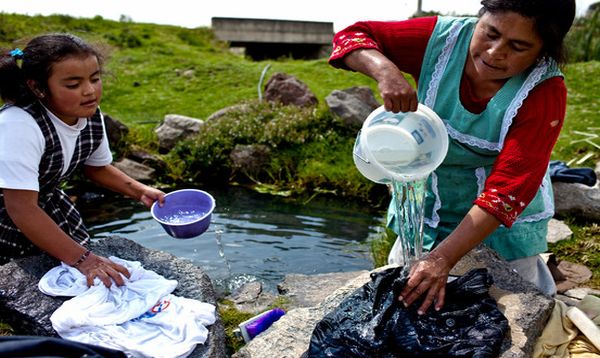Mexico City, Mexico — It turns out a partial solution to this unwieldy megacity's vexing water problem may have been under residents' feet all along — albeit a long way down.
Mexico City government officials announced this week the discovery of an aquifer more than a mile below ground that could provide enough water for at least some of the metropolitan area's 20 million residents for the next 100 years.
Officials say the aquifer could reduce the city's dependence on water pumped from outlying areas and reduce the strain on the region's shallower aquifers — the over-pumping of which is causing the city to sink precipitously, in some cases more than a foot a year.
The city's water department drilled an exploratory well recently in the eastern borough of Iztapalapa, a densely packed urban zone where the quality of water — much of which is drawn from shallower depths — is poor enough to be the punch line for many local jokes.
The news of a new water source was received with excitement in a city where experts have been predicting that demand for water could eventually outstrip supply. During a severe drought in 2009, some poorer neighborhoods were denied water service or subject to severe rationing. The city government hauled water into some areas by truck.
In a front-page article Monday in the newspaper Reforma bearing the fevered headline "Water in Sight!" the director of the city water system, Ramon Aguirre, described the discovery as "one of the biggest historical successes for the city."
In a subsequent radio interview, however, Aguirre emphasized that there was still much to be done, in conjunction with the federal government, to confirm the size of the aquifer and determine how much water could be extracted from it. “Even if there’s more than 100 years of extractable water ... that doesn’t mean it’s enough to supply the entire city for more than 100 years. That difference needs to be pointed out.”
Aguirre said he expected the city to initially drill five wells to draw water from the aquifer, a project that could cost about $40 million.
Federico Mooser, a veteran geologist who helped the city with its exploratory well in Iztapalapa, said in a phone interview Monday that the aquifer would not solve Mexico City's water problem. "This is a lucky finding of medium importance," he said.
Still, Mooser said, it was a promising new source of water that, while not drinkable, could be made so with relatively inexpensive treatment. Just as important, he said, the aquifer is deep enough that tapping it would not cause subsidence.
"That's very important," he said. "Because with every well that we have in Mexico City, we take water out, and we sink."
The sinkage is an aesthetic problem, of course, obvious to the casual tourist: numerous sacrosanct colonial buildings in the heart of the city list to one side or the other like dissolute revelers. But the subsidence also strains underground infrastructure, cracking municipal water pipes. That only adds to the water-supply problem.
 |
While two-thirds of Mexico City's water is drawn from its overtaxed aquifers, the remainder is imported from outlying river basins, according to David Barkin, an economics professor at Mexico City's Autonomous Metropolitan University who has studied water issues. Importing water from beyond city limits has created water shortages among campesinos and indigenous people, exacerbating their poverty, Barkin said.
Despite the discovery of the aquifer, part of the metropolitan area's long-term water solution will have to include the construction of more water treatment plants to recycle used water. One such plant, described by federal authorities as one of the world's largest, is planned in the nearby state of Hidalgo.
Experts say the city must also expand its system for catching rainwater and improve its conservation programs. Barkin has been urging the city to return its many rivers — which are currently piped out of the city to avoid flooding — to something closer to their natural state, allowing the city to draw some for use in the municipal water supply.
Barkin acknowledged that this plan could mean relocating some Mexico City residents. That, in turn, could be a problem in a city where politics and protest tend to run hot.


